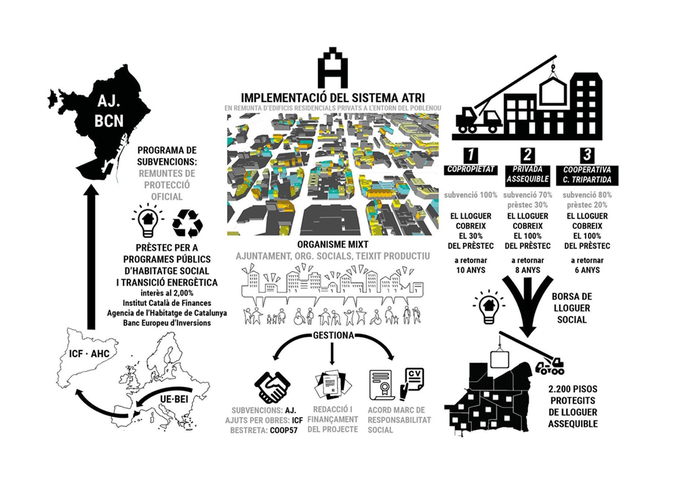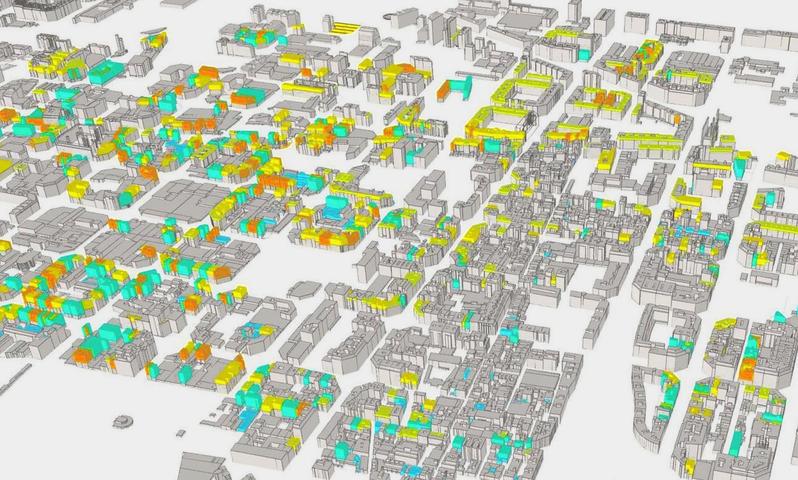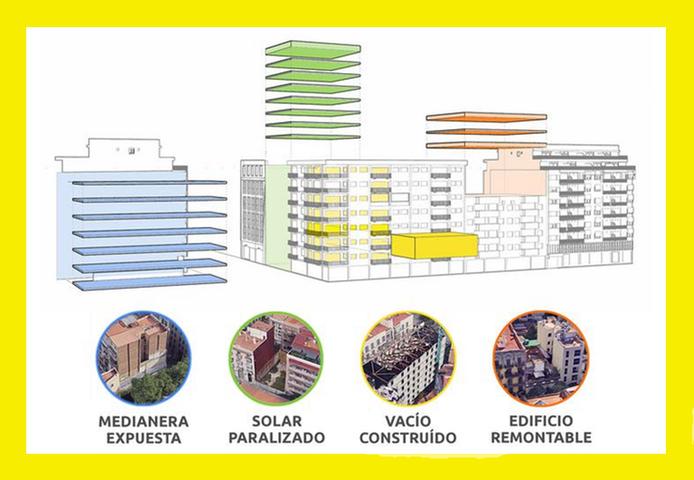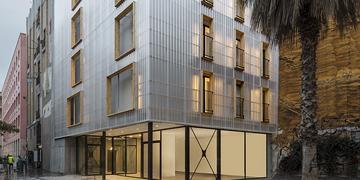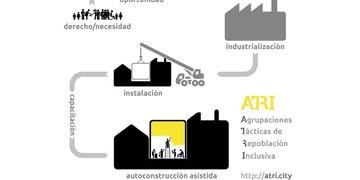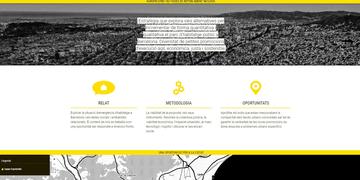implementation of the ATRI system in Poblenou
ATRI on the rise of private buildings with affordable housing
We have participated in the preparation and coordination of the Feasibility Study for the implementation of the ATRI system on the rise of private buildings with affordable housing in the Poblenou area. It was completed in July 2020 and commissioned by the Municipal Institute of Housing and Rehabilitation (IMHAB) and the Department of Housing of the Barcelona City Council.
This study emerges from the ATRI project and has been carried out by La Hidra Cooperativa, Sara Bellés Vallet, David Bravo, Pablo Feu, Álex Giménez Imirizaldu and Alfredo Palomera Zaidel.
The commission consisted of exploring the potential of increasing the affordable housing stock through the construction of ATRIs as additional floors, taking advantage of the unbuilt right to overhang. This study has been based solely on privately owned properties in the Poblenou neighborhood (Sant Martí district) and taking into account current planning.
ATRI proposes the construction of affordable housing on consolidated urban land, with sustainability criteria, and improvement of the energy efficiency of the built stock. It is proposed as a policy with three dimensions:
- Improve the right to housing: Combat gentrification and consolidate the social and functional mix in equipped, walkable neighborhoods, served by public transport.
- Increase the energy efficiency of the built stock: It improves the thermal, energy and accessibility features of the existing residential stock.
- Redistribute opportunities: Affordable housing is understood as an economic engine that creates jobs and reinforces the local and responsible productive fabric.
MAIN RESULTS OF THE STUDY
-The territorial exploration of the study estimates that it would be possible to build 2,229 new affordable houses in the Poblenou area without the need to acquire land.
-With the drafting of the new MPGM 22 @ being carried out by the City Council, the number of new affordable houses could increase to 6,398.
-ATRI is an urban improvement tool that does not commercialize the promotion of housing, since there are no monetary exchanges for the acquisition of the right to overhang. It is committed to a cooperation between the parties where the property owner agrees to the creation of new affordable houses for 99 years through public financing lines, which allow to rehabilitate the property and subsidize the construction of the additional floors.
-The construction of the new houses does not imply any direct cost for the property. A line of aid from non-refundable grants is proposed in which the City Council covers between 70% and 80%. Facilitating loans through public financial entities and supporting communities in defining projects, requesting aid and monitoring the works.
-In the established model it is the administration, and not the private developers, who lead the urban transformation processes. This allows prioritizing social and environmental objectives over profit or speculative purposes.
ATRI INNOVATES IN PUBLIC-COMMUNITY CO-PRODUCTION
ATRI can be an opportunity to generate a framework for public-community collaboration. However, a transformative policy only happens if it confronts the current urban development model in the hands of large companies and through consortia or public-private partnerships.
For this to be possible, it is necessary to innovate in public procurement and create hybrid organizations that make possible this transfer of resources to the responsible productive fabric.
The creation of a mixed body is proposed, made up of the City Council, companies and social organizations. Also an Acord marc that allows the creation of a Social Business Exchange in which the City Council would entrust the rehabilitation works. This exchange would be created from a public tender for the approval of companies in the sector with the criteria of social and environmental responsibility.
Three types of property are also conceptualized for new houses: Public Property, Affordable Private Property and Collective Property.
Public ownership
-Model 1: Co-ownership. The City Council, who executes the works and the management of future rentals, acquires the right to overhang at a cost of € 0 for ninety-nine years free of charge.
Affordable Private Property
-Model 2: Affordable private property. It is the same community of goods (property held jointly) that carries out the floor addition works with a partial public subsidy.
Collective Property
-Model 3a: Cooperative in assignment of use. The community constitutes a Cooperative for the Assignment of Use, or delegates to an already established one, the floor addition works and the operation of the new affordable housing.
-Model 3b: Tripartite community. It is a tool for intervention and social cohesion that promotes affordable housing and permanence in the territory, when there is a strong involvement of the community and strong territorial ties. This figure is designed for areas with great social needs and when the property does not have enough capacity to invest. It implies the involvement of three actors: the public administration; community; and a non-profit entity. The degree of involvement of these three actors can change according to each case. What is important about this model is that the criteria for access to housing is defined by territorial roots and participatory governance.
This study emerges from the ATRI project and has been carried out by La Hidra Cooperativa, Sara Bellés Vallet, David Bravo, Pablo Feu, Álex Giménez Imirizaldu and Alfredo Palomera Zaidel.
The commission consisted of exploring the potential of increasing the affordable housing stock through the construction of ATRIs as additional floors, taking advantage of the unbuilt right to overhang. This study has been based solely on privately owned properties in the Poblenou neighborhood (Sant Martí district) and taking into account current planning.
ATRI proposes the construction of affordable housing on consolidated urban land, with sustainability criteria, and improvement of the energy efficiency of the built stock. It is proposed as a policy with three dimensions:
- Improve the right to housing: Combat gentrification and consolidate the social and functional mix in equipped, walkable neighborhoods, served by public transport.
- Increase the energy efficiency of the built stock: It improves the thermal, energy and accessibility features of the existing residential stock.
- Redistribute opportunities: Affordable housing is understood as an economic engine that creates jobs and reinforces the local and responsible productive fabric.
MAIN RESULTS OF THE STUDY
-The territorial exploration of the study estimates that it would be possible to build 2,229 new affordable houses in the Poblenou area without the need to acquire land.
-With the drafting of the new MPGM 22 @ being carried out by the City Council, the number of new affordable houses could increase to 6,398.
-ATRI is an urban improvement tool that does not commercialize the promotion of housing, since there are no monetary exchanges for the acquisition of the right to overhang. It is committed to a cooperation between the parties where the property owner agrees to the creation of new affordable houses for 99 years through public financing lines, which allow to rehabilitate the property and subsidize the construction of the additional floors.
-The construction of the new houses does not imply any direct cost for the property. A line of aid from non-refundable grants is proposed in which the City Council covers between 70% and 80%. Facilitating loans through public financial entities and supporting communities in defining projects, requesting aid and monitoring the works.
-In the established model it is the administration, and not the private developers, who lead the urban transformation processes. This allows prioritizing social and environmental objectives over profit or speculative purposes.
ATRI INNOVATES IN PUBLIC-COMMUNITY CO-PRODUCTION
ATRI can be an opportunity to generate a framework for public-community collaboration. However, a transformative policy only happens if it confronts the current urban development model in the hands of large companies and through consortia or public-private partnerships.
For this to be possible, it is necessary to innovate in public procurement and create hybrid organizations that make possible this transfer of resources to the responsible productive fabric.
The creation of a mixed body is proposed, made up of the City Council, companies and social organizations. Also an Acord marc that allows the creation of a Social Business Exchange in which the City Council would entrust the rehabilitation works. This exchange would be created from a public tender for the approval of companies in the sector with the criteria of social and environmental responsibility.
Three types of property are also conceptualized for new houses: Public Property, Affordable Private Property and Collective Property.
Public ownership
-Model 1: Co-ownership. The City Council, who executes the works and the management of future rentals, acquires the right to overhang at a cost of € 0 for ninety-nine years free of charge.
Affordable Private Property
-Model 2: Affordable private property. It is the same community of goods (property held jointly) that carries out the floor addition works with a partial public subsidy.
Collective Property
-Model 3a: Cooperative in assignment of use. The community constitutes a Cooperative for the Assignment of Use, or delegates to an already established one, the floor addition works and the operation of the new affordable housing.
-Model 3b: Tripartite community. It is a tool for intervention and social cohesion that promotes affordable housing and permanence in the territory, when there is a strong involvement of the community and strong territorial ties. This figure is designed for areas with great social needs and when the property does not have enough capacity to invest. It implies the involvement of three actors: the public administration; community; and a non-profit entity. The degree of involvement of these three actors can change according to each case. What is important about this model is that the criteria for access to housing is defined by territorial roots and participatory governance.

-
This content has no related links
-
This content has no related downloads

